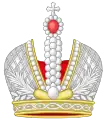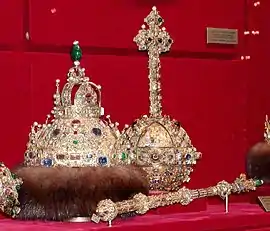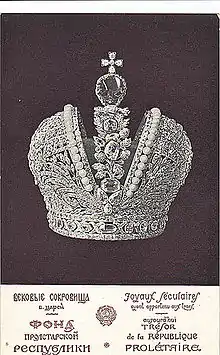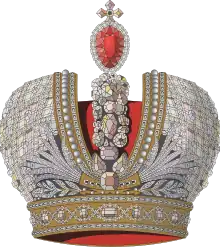Imperial Crown of Russia
The Imperial Crown of Russia (Russian: Императорская Корона России), also known as the Great Imperial Crown (Russian: Великая Императорская Корона), was used by the monarchs of Russia from 1762 until the Russian monarchy's abolition in 1917. The Great Imperial Crown was first used in a coronation by Catherine the Great, and it was last worn at the coronation of Nicholas II. It was displayed prominently next to Nicholas II on a cushion at the State Opening of the Russian Duma inside the Winter Palace in St. Petersburg in 1906. It survived the 1917 revolution and is currently on display in Moscow at the Kremlin Armoury's State Diamond Fund.
| Imperial Crown of Russia | |
|---|---|
_-_photo_by_Shakko_01.JPG.webp) Modern replica using real gems and white gold | |
| Heraldic depictions | |
 | |
| Details | |
| Country | Russian Empire |
| Made | 1762 |
| Owner | State Diamond Fund |
| Weight | 4.08 kg (9 lb) |
| Arches | 2 |
| Cap | Red velvet |
| Notable stones | 4,936 diamonds 74 pearls 1 red spinel |
Background

By 1613, when Michael Romanov, the first Tsar of the Romanov Dynasty, was crowned, the Russian regalia included a pectoral cross,[2] a golden chain,[3] a barmas (wide ceremonial collar),[4] the Crown of Monomakh, sceptre,[5] and orb.[6] Over the centuries, various Tsars had fashioned their own private crowns, modeled for the most part after the Crown of Monomakh, but these were for personal use and not for the coronation.
In 1719, Tsar Peter the Great founded the earliest version of what is now known as the Russian Federation's State Diamond Fund. Peter had visited other European nations, and introduced many innovations to Russia, one of which was the creation of a permanent fund (фонд) to house a collection of jewels that belonged not to the Romanov family, but to the Russian State. Peter placed all of the regalia in this fund and declared that the state holdings were inviolate and could not be altered, sold, or given away — and he also decreed that each subsequent Emperor or Empress should leave a certain number of pieces acquired during their reign to the State, for the permanent glory of the Russian Empire.
From this collection came a new set of regalia, including eventually the Great Imperial Crown, to replace the Crown of Monomakh and other crowns[7] used by earlier Russian Tsars and Grand Princes of Muscovy, as a symbol of the adoption of the new title of Emperor (1721).
Manufacture

The court jeweller Ekart and Jérémie Pauzié made the Great Imperial Crown for the coronation of Catherine the Great in 1762. The beautiful crown reflects Pauzié's skilled workmanship. It is adorned with 4936 diamonds arranged in splendid patterns across the entire surface of the crown. Bordering the edges of the "mitre" are a number of fine, large white pearls. The crown is also decorated with one of the seven historic stones of the Russian Diamond Collection: a large precious red spinel weighing 398.72 carats (79.744 g), which was brought to Russia by Nicholas Spafary, the Russian envoy to China from 1675 to 1678. It is believed to be the second largest spinel in the world.
In formally adopting the Western term "Emperor" for the ruler of Russia, Peter the Great also adopted Western imperial symbols, including the form of the private crowns (Hauskrone) used by the Holy Roman Emperors (of which the only surviving example is the Austrian imperial crown of Rudolf II, the Imperial Crown of Austria), in which a circlet with eight fleur-de-lis surrounds a mitre with a high arch extending from the front to the back fleur-de-lis. Already in Austria some baroque representations of this type of crown found on statues of the saints had transformed the two halves of the mitre into two half-spheres, and this is the type of imperial crown used in Russia. Peter’s widow and successor, Catherine I, was the first Russian ruler to wear this form of imperial crown.
In the Great Imperial Crown which the court jewellers Pauzié and J. F. Loubierin made for Catherine II in 1762, these hemispheres are in open metalwork resembling basketwork with the edges of both the hemispheres bordered with a row of 37 very fine, large, white pearls. They rest on a circlet of nineteen diamonds, all averaging over 5 carats (1.0 g) in weight, the largest being the large Indian pear-shaped stone of 12⅝ cts in front, set between two bands of diamonds above and below. Posier showed his creative genius by replacing the eight fleur-de-lis with four pairs of crossed palm branches, while the arch between them is made up of oaks leaves and acorns in small diamonds surrounding a number of large diamonds of various shapes and tints [8] running from the front pair of crossed palms to the back pair of crossed palms, while the basketwork pattern of the two hemispheres are divided by two strips of similar oak leaves and acorns from the two side pairs of palm branches stretching up to the rows of large pearls on their borders. At the center and apex of the central arch is a diamond rosette of twelve petals from which rises a large red spinel, weighing 398.72 carats (79.744 grams), one of the seven historic stones of the Russian Diamond Collection, which was brought to Russia by Nicholas Spafary, the Russian envoy to China from 1675 to 1678. It is believed to be the second largest spinel in the world.[9] This spinel, in turn, is surmounted by a cross of five diamonds, representing the Christian faith of the Sovereign, the God-given power of the monarchy and the supremacy of the divine order over earthly power. Except for the two rows of large white pearls the entire surface of the crown is covered with 4936 diamonds and is quite heavy, weighing approximately nine pounds (by contrast, the Crown of Monomakh weighs only two pounds).[10] It was unfinished in time for Catherine's coronation and the original colored stones (e.g., emeralds in the palm branches and laurel leaves) were replaced with diamonds for the coronation of Paul I in 1797. It was used at every subsequent coronation until that of Nicholas II in 1896 and was last in imperial period at the State Opening of the Duma in 1906.
There was also a Lesser Imperial Crown, very similar in style and workmanship to the Great Imperial Crown, only smaller and entirely set with diamonds, made for Empress Maria Feodorovna, the consort of Paul I, that was used for the coronation of the Tsarina. At the coronation of Nicholas II in 1896, the smaller crown was worn by Dowager Empress Maria Feodorovna, as was her right as a crowned Empress. A second identical lesser Imperial Crown was made for the young Empress Alexandra Feodorovna to wear. Dowager Empresses outranked reigning Empress Consorts at the Russian Court.
In 1900, the workshop of Peter Carl Fabergé in St. Petersburg made a replica in miniature of the Imperial Regalia (the Great Imperial Crown, the Lesser Imperial Crown, the Imperial Orb and Sceptre) out of silver, gold, diamonds, sapphires, and rubies, the whole set on a marble pedestal. The work is now in the collection of the Hermitage Museum.
Coronation
.jpg.webp)
Following the tradition of the Byzantine Emperors, the Tsar of Russia placed the crown upon his own head. This left no doubt that, in the Russian system, the imperial power came directly from God. The prayer of the Metropolitan, similar to that of the Patriarch of Constantinople for the Byzantine Emperor, confirmed the imperial supremacy.
A few days prior to the crowning service itself, the Tsar made a processional entry into Moscow, where coronations were always held (even when the capital was in St. Petersburg). Following this, the Imperial regalia were brought from the Kremlin armory into the Tsar's Kremlin palace, where they would accompany the new emperor on his procession to the Dormition Cathedral on the morning of his coronation. This procession commenced at the Red Porch and ended at the church doors, where the presiding prelate and other bishops blessed the Tsar and his consort with holy water and offered them the Holy Cross to kiss.
After the Tsar entered the cathedral, he and his spouse venerated the icons there and took their places on two thrones set up in the center of the cathedral. After the sovereign had recited the Nicene Creed as his profession of faith, and after an invocation of the Holy Ghost and a litany, the emperor assumed the purple chlamys, and the crown was then presented to him. He took it and placed it on his head himself, while the Metropolitan recited:
In the name of the Father, and of the Son, and of the Holy Spirit, Amen.
The Metropolitan would then make the following short address:
Most God-fearing, absolute, and mighty Lord, Tsar of all the Russias, this visible and tangible adornment of thy head is an eloquent symbol that thou, as the head of the whole Russian people, art invisibly crowned by the King of kings, Christ, with a most ample blessing, seeing that He bestows upon thee entire authority over His people.
Following this, the new Tsar crowned his consort, first briefly with his own crown (by touching it momentarily to her head before putting it back on his own), then with a smaller crown of her own. Further prayers and litanies were read, then the Emperor was anointed just prior to reception of Holy Communion during the Divine Liturgy. He was invited to enter the altar area through the Royal Doors (normally reserved solely to the clergy) and partake of Communion as a priest would. Further prayers and blessings concluded the service, which was followed by a special feast held in the Kremlin's Palace of Facets.
Russia's last coronation was in 1896, for Tsar Nicholas II and Empress Alexandra. The last occasion on which the Great Imperial Crown was officially used was the State Opening of the Duma in 1906.[11]
First World War, revolution and the Soviet period

In 1913, Agathon Fabergé, son of Peter Carl Fabergé of the House of Fabergé, the crown jewellers, recommended that the Imperial regalia be re-catalogued and overhauled. The tsar gave his approval and by July 1914, work on the Imperial orb and sceptre had been completed, and work was about to commence on the crowns.[12] Rising tensions and the outbreak of the First World War put a stop to further work, and the regalia items were loaded into nine strong-boxes and sent from Saint Petersburg to Moscow for safekeeping. They were stored in the Kremlin Armoury.[12] The crown remained there with the rest of the regalia during and after the February and October Revolutions in 1917.
In 1922, they were re-catalogued and transferred to the State Treasury.[13] The crown and other pieces of jewellery and regalia were collected into the State Depository of Treasures, later the Diamond Fund, and discussions were carried out with French and British experts as to the possibility of selling off some of the crown jewels to raise foreign currency. The experts advised against selling such pieces as the crown, orb and sceptre, arguing that they were unlikely to attract their historic worth.[14] Nevertheless, the crown jewels were exhibited in 1922 for two journalists of the New York Times, who later wrote:
'Here', says Begasheff [head of the jewellery commission], opening the box with hands that tremble ever so little despite his air of unconcern, 'is the crown of the Emperor, 32,800 carats of diamonds.'
'Is it heavy?'
'No', said one of the workmen, '5 pounds at most - try it,' and placed it straight away on my head.[15]
Heraldic use

The Imperial Crown appeared on the National emblems of the Russian Empire — the Great Coat of arms (Большой государственный герб Российской Империи), the Medium Coat of Arms (Средний государственный герб Российской Империи), and the Lesser Coat of Arms (Малый государственный герб Российской Империи) of Imperial Russia.
The Great Imperial Crown was placed above the Imperial Cypher (monogram) — but only after the coronation. Between ascending the throne and the coronation, the Imperial Cypher would bear the princely crown, but not the Imperial Crown.[16]
The crown was also placed on the arms of Congress Poland, a semi-independent state in a personal union with the Russian Empire (1814–1915), and the Privislinsky Krai which was incorporated into the empire in 1831.
Since December 20, 2000, the Imperial Crown has appeared on the coat of arms of the Russian Federation.
Some cities and oblasts of Russia have their coat of arms depicting the Imperial Crown.
See also
- Imperial crown
- Monomakh's Cap (the crown used before the Great Imperial Crown)
- Orlov diamond (set in the Russian Imperial Sceptre)
Notes
- The crown is styled after the Monomakh Cap and was made for Tsar Michael Fyodorovich by Kremlin masters in 1627. The orb and sceptre are of Western European origin and may have been given to Tsar Boris Godunov in 1604.
- "pectoral cross". Kreml.ru. 1997-11-28. Retrieved 2012-10-09.
- "golden chain". Kreml.ru. 1997-11-28. Retrieved 2012-10-09.
- "barmas". Kreml.ru. 1997-11-28. Retrieved 2012-10-09.
- "sceptre". Kreml.ru. 1997-11-28. Retrieved 2012-10-09.
- "orb". Kreml.ru. 1997-11-28. Retrieved 2012-10-09.
- "other crowns". Kreml.ru. 1997-11-28. Retrieved 2012-10-09.
- Including at the bottom of the arch in the front, a perfect 56 carats (11.2 g) diamond with a slight tint that had belonged to the Empress Elizabeth; above it another large brilliant of 41.3125 carats (8.26250 g); a four-sided brilliant of 18.375 carats (3.6750 g); a pink pendant of 21.875 carats (4.3750 g) and a bevelled four-sided oblong stone of 17.375 carats (3.4750 g), while from the back bottom is found a triangular Indian-cut brilliant of pinkish-blown tine of 17 3/16 cts; an oval boat-shaped bluish-white stone of 17⅛ cts; a long pendant with a light golden tint of 12¼ cts; a perfect, white rhomboid of 16½ cts and a four-sided thick stone of pink water of 12¼ cts.
- The largest and the fourth largest spinels weigh respectively 500 cts. and 270 cts. and are among the Iranian Crown Jewels; the third largest spinel is the Timur Ruby of 283 cts. in the Royal Collection of the British monarchy.
- R. Monk Zachariah Liebmann, "Martyrology of the Communist Yoke: The Life of Tsar-Martyr Nicholas II", The Orthodox Word, 153 (1990), 193–4.
- The Imperial Crown of Russia (1763) Archived 2011-06-11 at the Wayback Machine, accessed 2007-06-18.
- Clarke. The Lost Fortune of the Tsars. p. 151.
- Clarke. The Lost Fortune of the Tsars. p. 152.
- Clarke. The Lost Fortune of the Tsars. p. 172.
- Clarke. The Lost Fortune of the Tsars. p. 173.
- See for example, http://www.romanovrussia.com/MFcobaltEgg.html Archived 2009-01-20 at the Wayback Machine.
References
- Clarke, William (1994). The Lost Fortune of the Tsars. London: Weidenfeld & Nicolson. ISBN 0-297-81434-6.
External links
| Wikimedia Commons has media related to Great Imperial Crown. |
- Russian Crown Jewels
- Imperial Sceptre
- Regalia on display at the Kremlin Armoury
- Faberge's Miniatures of the Imperial Regalia
- Description of Coronation
- The Coronation of Tsar Nicholas II Royal Russia
- Official Coronation Album
- Speech From the Throne by Nicholas II at Opening of the State Duma, Winter Palace, 27 April 1906